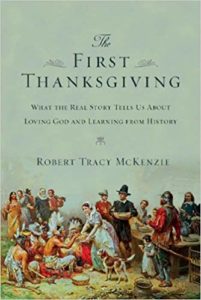
The First Thanksgiving: What the Real Story Tells Us about Loving God and Learning from History
Reviewed by Richard W. Pointer, History, Westmont College
When Westmont revised its General Education curriculum about ten years ago, we created a new requirement in “thinking historically.” Students may select from a range of courses offered through various departments (history, art history, religious studies, music, and so on) covering a myriad of historical subjects and time periods. We hope that students will learn the historical content relevant to that particular course. But our larger desire is for them to become better able to understand and practice history. That means getting them to think more deeply regarding what is distinctive about history as a mode of inquiry alongside many other ways of thinking. In the end, we want them to have developed more of the requisite skills and more of the appropriate habits of mind and heart to approach the past – any past – well. That often proves a daunting and humbling task for teacher and student alike.
Fortunate we are, then, when other colleagues come along and offer rich wisdom for the journey. Such is the case with Robert Tracy McKenzie’s The First Thanksgiving. Chair of the history department at Wheaton College, McKenzie brings to bear all the fruit of his earlier experience at the University of Washington where he held an endowed chair and now at Wheaton in writing a book that exemplifies from beginning to end how to think historically and Christianly about the past. McKenzie wants to help Christian believers do a better job of that, especially in relation to American history. And he thinks “Thanksgiving is a good place to start” (10). What follows then is a case study of sorts. McKenzie uses the story of the Pilgrims and the subsequent history of the Thanksgiving holiday in America as a means to convey his insights about appropriate and inappropriate ways of interacting with the past. But he also wants to teach us some real history about the Pilgrims and about Thanksgiving. On both counts, he succeeds admirably.
So why Thanksgiving? McKenzie may very well have chosen it out of personal interest in the Pilgrims but he also sees it as a ripe choice because of its central place in how Americans conceive of how we began as a people and a nation. It is one of those founding myths that continue to shape American identity. Christians would do well, therefore, to understand its origins and development, and reflect carefully on its ongoing meaning. To that end, McKenzie presents a series of well-researched chapters that detail who the Pilgrims were, why they came to America, what their early Thanksgivings were like, and how later generations of Americans, particularly in the nineteenth century, found in the Pilgrims a usable past for establishing a national Thanksgiving holiday. Along the way, he points up numerous places where popular notions of Pilgrim history need adjustment: these Separatists left Holland largely because they feared the corrupting influence of the surrounding culture, not to escape religious persecution; the event we take to be the first Thanksgiving the Pilgrims would not have considered a religious event; their Thanksgiving dinner would have included few of the foods we like to consume at ours and may or may not have included Indians; as the Europeans and native peoples met that day, the tone in the air would have been more one of tension than celebration; and many of the values later Americans have ascribed to the Pilgrims – rugged individualism, Jeffersonian freedom, democratic practices – would in fact have been very alien to their community. Such a list of historical corrections may imply that McKenzie is simply engaged in a debunking exercise. But that would undersell what he is about here. He surely wants to separate fact from fiction where the Pilgrims are concerned. Yet his goal is less one of deconstruction and more one of reconstruction as he offers a better historical portrait of these people from whom he thinks contemporary believers can learn much.
Like many American Christians, McKenzie admires the Pilgrims and finds much in their faith and practice worth emulating. He even thinks we might find some heroes in their midst. He says that is okay as long as we do not go further and turn them into idols. Recognizing the frailties and faults even of those we most admire and appreciate in the past is a mark of good historical thinking. So, too, are a host of other practices he introduces and models throughout the book: scrutinize your evidence for both its possibilities and limitations; contextualize all historical events; recognize the differences between the historical moment of your subjects and your own time; embrace intellectual humility about what can be known about any past; avoid using the past for self-serving or self-justifying purposes; discard false memories; acknowledge that the study of history is an interpretive discipline bound to ongoing revision; and allow the past to instruct you and to question your own convictions and values.
That final point is especially important for McKenzie. He believes that we must not only learn about the past but also from the past. He writes, “Whatever our subject, at some point we must stop and ask of the knowledge we are acquiring, Why is this important? Why does this matter, now, to me?” (16). In other words, how shall we then live? Or in this specific case, how shall we then do Thanksgiving? McKenzie offers some helpful advice on the latter question but more importantly, tackles the larger issue of how best to relate past and present. In a book filled with lamentable examples of Americans turning the Pilgrims into whatever they wanted or needed in their current historical moment, we might expect McKenzie to tell us to leave the past in the past. But he is bolder than that. He wants us to embrace historical study “as a framework for explicit moral inquiry” (181). For him, that means allowing the past to interrogate the moral quality of our lives rather than our making moral judgments about their lives. Practicing such moral reflection entails making “ourselves vulnerable to the past, when we figuratively resurrect the dead and allow their words and actions to speak to us, even ‘to put our lives to the test’” (182). McKenzie illustrates what he has in mind by suggesting some of the things he and other believers might learn by listening to the Pilgrims. All of this makes eminently good sense and embodies real Christian wisdom, though I wonder whether McKenzie backs away too quickly from any form of moral judgment in historical study. As exemplified by a book such as Harry Stout’s Upon the Altar of the Nation, there seems to be some place for a type of “moral history” that wrestles rigorously with the moral complexities and failings of past peoples.1
It is no doubt too hopeful to imagine that The First Thanksgiving will change how large numbers of Americans understand the Pilgrims or look upon Thanksgiving. But one can hope that the book makes its way into the hands of a wide range of audiences including Christian college students and faculty, elementary and secondary education teachers, adult Christian education classes, general Christian readers, and even secular university classes interested in an excellent primer on thinking historically. If it does, there is some chance by the time Americans sit down to celebrate the 400th anniversary of the Pilgrims’ first Thanksgiving in 2021, more of us will be better equipped to receive well the gifts that historical study can provide, including the feast that our Pilgrim forefathers and mothers offer.























